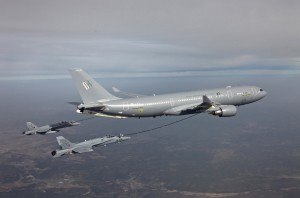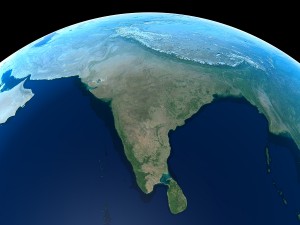2013-01-24 by Robbin Laird
Often, the acquisition of a new defense platform is discussed in terms of itself and the entire operational impact or strategic context is lost. This is the usual case with the most innovative air tanker solution to date, namely the A330MRTT.
The A330MRTT deployed as a fleet can provide a significant deployable airborne infrastructure to support wide-ranging military and security operations.
In effect, considered as a fleet, the A330MRTT can provide – notably with regard to its refuelable version – with a very flexible deployment asset, which can be shaped appropriate to the combat or security tasks.
Deployed as a Fleet
The A330 MRTT tanker as a fleet provides the possibility for a network of flying air support systems engaged for a long time in an operational setting.
Much depends on how these assets become configured.
With the fuel carried in the wings, the large deck of the A330 can be used to host a variety of air support capabilities: routers, sensors, communication nodes, etc. It does not have to be simply a flying gas can.
Such a configuration along with the fuel re-supply capabilities of the A330 tanker makes this a flying air operational support asset.

If the model selected is similar to the model downselected initially by the USAF, it is refuelable in flight.
With the space available in the aircraft – again because of the fact that the fuel for refueling is carried in the wings – a crew rest area can be provided.
This means that the air tankers can stay aloft for a significant period of time as the refuelers are themselves refueled.
This in turn means that the refueling aircraft as a fleet can have a strategic impact.Once the planes are airborne and they have access to refuelers for their own operational autonomy, the fleet can tank a variety of national or coalition partners operating from dispersed or diverse airfields.
And the discretion possible airborne can allow nations to tank a variety of coalition partners, some of whom might not be favorite candidates if seen on the ground.
The Indian Decision
As the Airbus Military Press (January 7, 2013) release has put it:
Airbus Military is pleased to confirm that it has been selected by the Government of India as the preferred bidder to supply its A330 MRTT Multi Role Tanker Transport to the Indian Air Force (IAF).
The decision follows a lengthy and thorough selection process including the completion of extensive flight demonstrations in India by the A330 MRTT during which the aircraft refuelled multiple types of IAF fighters and operated from the high-altitude IAF base at Leh.
Detailed negotiations will now begin which it is expected will lead to the award of a final production contract for an envisaged six aircraft in 2013.
The competition was between an upgraded Indian legacy aircraft – the IL-78 – and the A330MRTT. The IL-78 is based on the IL-76 airframe.
According to Wikipedia:
The Il-76 tanker was conceived as long ago as 1968, but the transferable fuel load for the initial version was only 10 tonnes, which was insufficient, so development was shelved. When the higher performance Il-76 became available the tanker project was restarted in 1982 as the IL-78.
In addition to the increased fuel load of the late model IL-76, the IL-78 has two removable 18,230-liter fuel tanks installed in the freight hold, giving transferable loads of 85,720 kg (189,000 lb) (with hold tanks) or 57,720 kg (127,300 lb) (without). Controlled from the gunner station, which is stripped of military equipment, three aircraft can refuel in flight simultaneously from the UPAZ-1A (IL-78) / UPAZ-1M (IL-78M) 26m refuelling pods fitted to the outer wings and rear fuselage. In addition, four aircraft can also be refuelled on the ground using conventional refueling hoses extending from the freight hold. Because of the aircraft’s high all-up weight after take-off, which in an emergency would mean landing at weights well in excess of maximum allowable landing weight, the IL-78 has a fuel jettison system with jettison ports at the wingtips.
Soon after the IL-78 passed acceptance tests in 1984, Ilyushin was instructed to design and produce an upgraded version to be known as IL-78M. The IL-78M is a dedicated tanker and cannot be converted back to the transport role easily. Adding a third freight hold tank increased transferable fuel to 105,720 kg (233,100 lb) and maximum take-off weight (MTOW) to 210,000 kg (460,000 lb), necessitating reinforcement of the wing torsion box. UPAZ-1M refueling pods improved maximum fuel flow to 2,900 l/min (638 Imp gal/min).
Because the Il-78M is not “convertible”, all cargo handling equipment was removed and cargo doors were deleted, saving approximately 5,000 kg (11,000 lb) in structural weight.
http://en.wikipedia.org/wiki/Ilyushin_Il-78
(Also see the following:
http://www.ilyushin.org/eng/products/military/78mk.html).
Instead of going for a modernized version of the IL-78, the Indians have announced their intention to go with the A330MRTT.
Such a decision is based on several considerations.
First, the fuel payload is greater on the A330MRTT. In terms of physical specs, the A330MRTT can carry 30% more fuel than the IL-78. And the greater fuel efficiency of the engines aboard the Airbus tanker will allow for de facto even greater capability to deliver more fuel to the Indian deployed air fleet.
Second, the A330MRTT can carry more passengers than the IL-78. The Airbus tanker can carry more than 300 passengers as opposed to around 250 aboard the IL-78.
Third, the A330MRTT has significantly expanded MRO options than the IL-78. The IL-78 is a specialized aircraft and requires contractor specific support. The advantage of the A300MRTT is that it is an A330. Indian can have a wide variety of MRO opportunities in the region for support for the aircraft. The Indians can craft a cost effective, combat effective MRO solution set.
Fourth, the Indians are buying a new tanker to deal with the current fleet, but to prepare for their overall modernization. The P-8 is entering the inventory and is boom-ready and having a boom capable tanker makes a great deal of sense to expand Indian options over the next 50 years.
Currently, the Indians fly with only a hose-drogue refueling system. This is clearly limiting when it comes to combat fleet modernization.
In other words, the A330MRTT option will allow the Indians to deal with current needs but to lay a foundation for effective support of their modernization options.
The Indian Case
Dependent upon how the Indians address the use of the platform, the A330MRTT could become a key element not only enhancing operational capability but innovation as well.
The strategic challenge facing India was well articulated by Robert Kaplan in his book, Monsoon: The Indian Ocean and the Future of American Power.
According to Kaplan, China is expanding vertically and India horizontally on the global stage.
Competition between India and China, caused by their spreading and overlapping layers of commercial and political influence, will play out less on land than in a naval realm. Zhao Nanqi, when he was the director of the general staff logistics department in the Chinese navy, proclaimed: “We can no longer accept the Indian Ocean as an ocean only of the Indians.”
This attitude applies particularly to the Bay of Bengal, where both nations will have considerable maritime presences, owing to the closeness of Burma as well as the Andaman and Nicobar Islands, possessed by India near the entrance of the Strait of Malacca.
Conversely, India’s and China’s mutual dependence on the same sea lanes could also lead to an alliance between them that, in some circumstances, might be implicitly hostile to the United States. In other words, the Indian Ocean will be where global power dynamics will be revealed. Together with the contiguous Near East and Central Asia, it constitutes the new Great Game in geopolitics.
But as India and China become more integrally connected with both Southeast Asia and the Middle East through trade, energy, and security agreements, the map of Asia is reemerging as a single organic unit, just as it was during earlier epochs in history—manifested now by an Indian Ocean map.
Kaplan, Robert D. (2010-10-19). Monsoon: The Indian Ocean and the Future of American Power (Kindle Locations 282-292, selections). Random House, Inc.. Kindle Edition.
The A330MRTT is an ideal tool to help India integrate its various maritime and air assets necessary to cover a wide territory for horizontal operations.
The sweep of the Indian operational area is evident simply from looking at the map.

India deploys its diversity of aircraft from more than 60 bases over the subcontinent.
http://en.wikipedia.org/wiki/List_of_Indian_Air_Force_bases
And it operates a virtual gaggle of aircraft, which as the fleet evolves could have really different tanking requirements and approaches.
The A330MRTT as a global tanker has been designed from the ground up to provide for the tanking of virtually every fighter, bomber or support aircraft flying today. And as the unmanned fleets or remotely piloted aircraft get added to the mix, the A330MRTT will be ready to refuel these as well.
In other words, the tanker is well designed for today and has growthability to deal with the next 50 years of the evolution of military aviation in mind. It is not narrowly constructed as a simple upgrade from the past but can grow with the combat and support fleets.
And the reach of the Indian navy will grow over time and with it deployed Naval aviation assets whose reach will be defined by the ability to be tanked and supported. The ambitious approach being suggested by the Indian Chief of Staff of the Navy will require a tanker with significant reach.
According to Ninad D. Sheth in a recent article in the Indian press:
The new Chief of Naval Staff Admiral D. K. Joshi takes command at a time of extraordinary expansion for the Indian Navy.
He has also gone on to say that the Indian Navy — the fifth largest in the world — is ready to protect the country’s economic interests in the South China Sea, particularly the oil blocks off the coast of Vietnam being explored by ONGC…..
According to the Defence Ministry, the Navy has added as many as fifteen ships over the last three years. This includes a leased nuclear submarine from Russia, the Akulla II class.
It will soon take delivery of the much-delayed Russian aircraft carrier retrofitted for Indian use, the INS Vikramaditya. Other ships include three “stealth” frigates of the Shivalik class, resupply tankers and fast attack boats.
The plan is to add five more ships every year for the next five years. The Navy has received a major boost in its surveillance capability with the acquisition of the US-made P8i aircraft, armed with Harpoon missiles. These aircraft will replace an aging fleet of Tu142 and IL38 aircraft of the 80s.
The aircraft carrier group and the nuclear submarine are capabilities, that could, over time, restore Indian maritime primacy in the Indian Ocean waters. The imperial Navy that India inherited from the British controlled seas from Aden to Singapore.
That sea control included an outreach capability over the three critical “chokepoints”— Bandar Abbas in the Persian Gulf, the straits south of Sri Lanka and the Malacca straits in the Singapore littoral.
http://www.thehindubusinessline.com/opinion/indian-navy-needs-a-wider-berth/article4181397.ece
In short, as India shapes a “horizontal” defense and security strategy, the Indians will add new air and naval platforms.
But equally important will be the infrastructure to support such deployed assets.
And no asset is more important than shaping an effective airborne support structure for the Indian forces being built in the 21st century.

